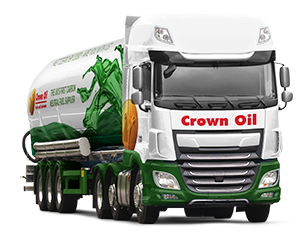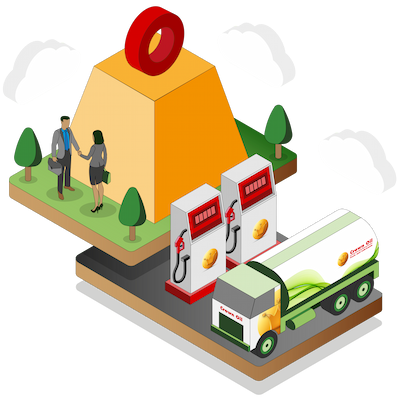Diesel Engines Are an Essential Part of Transport and Industry – Here’s How They Work
Diesel engines are an example of an internal combustion engine and are present across countless kinds of applications. These kinds of engines differ from petrol engines in that they are an example of a compression ignition engine, ie, they use high pressure to combust it’s fuel, instead of an ignition source (such as the spark that fires petrol engines)
While diesel engines are mostly associated with diesel cars and commercial road transport, they are relied on to carry out a range of work in all sorts of industries, from generating heat, generating electricity as well as moving vehicles. Crown Oil’s fuel experts explain how these engines work and where you’ll see them in action.
Trivia: diesel fuel is named after the engine for which it is manufactured, not the other way round. This is because the Diesel engine was invented by Rudolf Diesel. This is why you’ll sometimes see the Diesel capitalised, although we’ll stick to the common way of writing it.

Benefits versus negatives of diesel engines
The world’s reliance on fossil fuels arose out of necessity, and the fuels we use were always the best that industry could find from what was available at the time.
In the 19th century, oil lamps relied on whale oil, which had terrifying effects on ocean life. It wasn’t until 1854, when a cleaner-burning, more abundant and easier to produce alternative was produced by Canadian geologist Abraham Pineo Gesner through the distillation of crude oil that fuel consumption was able to switch to something better for the environment. At the time, this fuel was kerosene. From there, more petroleum products, such as diesel, petrol, lubricants were manufactured to serve industry, and the rest is history.
Since the earliest days of diesel engines, diesel has been a fuel of choice for several reasons. We take a look at them below:
Benefits and gas oil
- Fuel supply affordably meets demand
- Relatively efficient release of energy (compared to petrol)
- Clean burning (relative to petrol)
- Safe to be stored – stable at natural temperatures
- Diesel engines are heavy duty out of necessity
- Engines can remain operable for most temperatures experienced in the year
Benefits of diesel engines over petrol
The reason for the long list is because diesel engines are generally preferred over petrol as they allow for more torque and improved burning efficiency, although petrol does provide greater power than diesel fuel. However, this comes at a cost of burning faster, resulting in lower mileage than their diesel fuel counterparts.
The higher efficiency of diesel engines comes about from the higher pressures that these engines create when combusting their fuels, compared to petrol.
Because of these high pressures inside a diesel engine, they are built to be robust – meaning that they can be used in heavy-duty equipment, such as agricultural machinery and more.
Negatives of diesel and gas oil
Although diesel engines remain extremely popular, there are many downsides, particularly in regards to the high levels of emissions that fossil fuel diesel produces. In recent years, this has led to the rise in popularity of electric vehicles (EVs), but even EVs have compromises of their own.
- Non-renewable (blending and renewable drop-ins reduce or eliminate this issue)
- Oil drilling is damaging to the natural environment (modern, renewable drop-ins eliminate this issue)
- NOx content (Euro VI standards and AdBlue® systems significantly reduce this issue)
- Sulphur content is present in some classes of fuel (ULSD is the most common diesel, and sulphur presence is much lower)
- Petroleum-based diesel fuels are toxic to the environment when spilled (renewable drop-ins eliminate this issue)
- Gelling in cold temperatures (high-performance alternatives operate at a larger range of temperatures)
- FAME content means diesel is hygroscopic (so attracts water) and results in clogged filters and engine breakages (FAME-free alternatives do not have this issue)
- High levels of CO2 emissions (renewable alternatives reduce greenhouse gases by up to 90%)
- Air pollution and threat to human health (renewable fuels mitigate this)
Uses of diesel engines
While the diesel engine is most commonly associated with diesel-fuelled passenger cars and commercial vehicles that run on road diesel/DERV (ULSD/EN 590 diesel in the UK), it is not exclusive to transport.
Diesel engines (and in the case of off-road applications, gas oil or red diesel) are the power source of choice for many types of hardware:
- Passenger vehicles
- Vans
- Lorries
- Buses and coaches
- Tractors
- Harvesters
- Many utility vehicles and ATVs
- Leisure boats
- Larger sea vessels
- Diesel power generators
- Cranes
- Bulldozers
- Diggers
- Rail transport
- Diesel-powered forklifts
Of course, the above list is non-exhaustive. In fact, diesel fuel is not limited to the diesel engine – furnaces and commercial boilers in the UK regularly use gas oil as heating oil fuel. However, Industrial Heating Oil (IHO) is a much cleaner, more cost-effective drop-in alternative for heating businesses.
Fuels that can be used in diesel engines
For this reason, there are different types of diesel fuels that are authorised to be used in a diesel engine.
- Petroleum diesel (DERV or red diesel (gas oil))
- Paraffinic diesel (such as HVO fuel or GTL fuel)
- Biodiesel
Each type of fuel is produced to meet specifications that are intended for that kind of fuel. We have a dedicated specifications explainer that will explain these three fuels for diesel engines in closer detail.
Before switching to a petroleum alternative, check your engine’s warranty to ensure it covers your alternative fuel of choice or alternatively, call us today on 0330 123 1444 to speak to a member of our renewable fuels team.
What makes a diesel engine fuel?
The core property that fuels must have if they are to be used in a diesel engine is a specific cetane number. The cetane number quantifies out of 100 for how easily the oil combusts under pressure (the higher, the easier).
Mineral-based diesel has a cetane number of about 40, while higher performance alternatives such as HVO fuel or GTL fuel have a cetane score of 70 or greater, the higher cetane number results in improved burning – a fuel that more readily combusts and more complete burning, which itself provides cleaner emissions.
To be used in a diesel engine, fuels need to have an appropriate density and viscosity. For petroleum diesel fuel, this is between 0.82 – 0.835g/ml and its viscosity is between 2.0 and 4.5. Clean-burning alternatives need a similar density to diesel, however up to a 5.0 viscosity is required for paraffinic diesel fuels to ensure they meet the required regulations.
The fuel of choice for a diesel engine is based on what the engine will be used for. While most diesel engines are designed to run on middle distillate petroleum fuel, larger, more heavy-duty engines will be designed for use with heavier diesel fuel.
What about homemade biodiesel fuel?
There are some unofficial ways of powering diesel engines, such as mixing store-bought vegetable oil with reactants to create homemade biodiesel in order to save on fuel at fuel stations. While duty needs to be paid on an annual production of 2,500 litres and higher, if done at home, this fuel is produced entirely at your own risk.
Your vehicle’s warranty will likely not cover homemade fuel, and if poorly produced, it may result in damage to your engine, or worse yet, damage to your own and nearby property.
If your aim is to help the environment, you’re best off purchasing renewable fuels from specialist suppliers.
Diesel engine system
While there are many applications for diesel engines, the system is broadly the same, since the majority are four-stroke engines. That means power is harnessed in four steps (stroke cycles), which we go through below.
Before anything happens in the engine, fuel is pumped from the tank to the engine. The fuel passes through the fuel filter which removes any particles that could damage the engine or block the fuel injector nozzles – such as diesel bug, dirt, or in cold conditions, waxed FAME biodiesel which causes many problems in cold winter, to the point where the 7% biodiesel content in red diesel used in agriculture is sometimes reduced by refineries to assist farmers

Stroke 1 – Intake stroke
The appropriate amount of fuel is brought in through the fuel injection system and mixed with air in the pistons, where they become compressed.
Stroke 2 – Compression stroke
The intake valve closes and compression begins resulting in compressed air and fuel
Stroke 3 – Combustion stroke
Fuel, air under intense pressure combusts, releasing fumes of ignited diesel.
Stroke 4 – Exhaust stroke
Spent combustion gasses are forced out of the exhaust valves, through the exhaust manifold, and into the turbine (exhaust) side of the turbocharger.
Turbocharger
After the exhaust stroke, any remaining fuel fumes are sent through to the turbocharger. The turbocharger pressurises air into the cylinder which increases the oxygen content resulting in a better burn. In fact, the turbocharging process can increase the power of a diesel vehicle by 50% while reducing the engine’s fuel consumption by around 25%.

Emission reduction in diesel engines
Since 2015, diesel engines must meet Euro 6 standards in order to ensure minimal impact on the environment. To do this, engines have several systems in place:
Exhaust gas recirculation (EGR)
The EGR system is in place to reduce pollutants, specifically NOx emissions, coming from the exhaust.
Diesel Oxidation Catalyst (DOC)
The DOC oxidises unburnt fuel to CO2. Because of this system, hydrocarbons present in fuels are prevented from being blown out of the exhaust.
Diesel Particulate Filter (DPF)
The Diesel Particulate Filter works to reduce particulates (smoke) from the exhaust fumes, making sure the exhaust gases are clean and have as minimal impact on the environment as the Euro 6 standards can allow.
Selective Catalytic Reduction (SCR)
If you’re using a modern Euro 6 diesel engine, the exhaust fumes are then sent to the SCR system to remove harmful emissions with the use of diesel exhaust fluid (AUS 32, commonly called AdBlue).
In the SCR system, the SCR catalyst mixes exhaust fumes with AdBlue diesel engine fluid, resulting in the NOx particles being reduced to NH3 (ammonia) and water being expelled from the exhaust valve.
Because the exhaust fluid is added inside the diesel system, it is essential to use AdBlue that meets ISO 22241 specifications to avoid harming your engine with rogue particles. Crown Oil supplies AdBlue® across the UK for a wide range of customers.
Diesel power generators
For power generators that run on gas oil, the engine is similar to that of an automobile, with the key difference that the engine is connected to an alternator, which generates electricity.
Diesel furnaces and boilers
The mechanics of boilers that run on diesel fuel (gas oil or commercial heating oil) is different to diesel engines – the fuel is atomised under pressure and a spark combusts the fuel. The combusted fuel heats water in pipes, and from there the heated water travels through the central heating system keeping properties warm and providing hot tap water.
Maintenance of diesel engines
Diesel engines have a reputation for lasting years if well-maintained. Getting that long lifespan out of a diesel engine requires maintenance, and that means regularly servicing the hardware; replacing engine fluids and diesel engine oils that keep the engine lubricated and cool, as well as using high-performance fuels.
For a supply of diesel fuel and lubricants from a supplier that knows what works best with your machinery, call our DERV experts today on 0330 123 1444.





